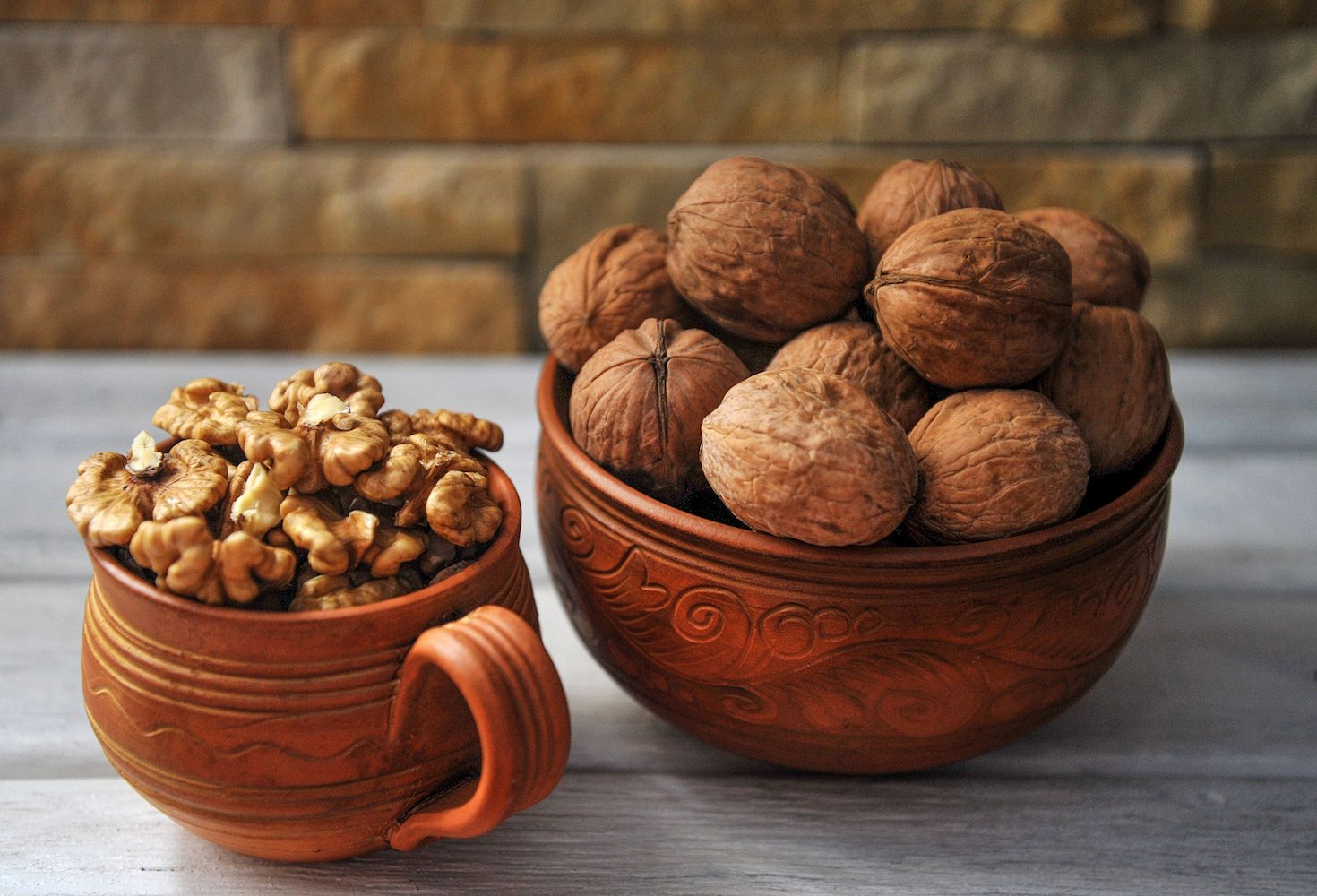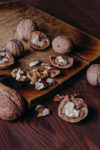
Black Walnut and English Walnut Recipes
There are basically two types of walnuts in the U.S. – English walnuts and black walnuts. Black walnuts grew wild in the southeast and midwest sections of the country and still do. Cracked black walnuts are expensive to buy because they are so labor-intensive to crack. They have a totally different taste from English walnuts, and are used mostly for candy and ice cream. Read more about black walnuts here.
INFORMATION BELOW FROM 1800s COOKBOOKS
CRACKING WALNUTS
It is more convenient to buy your nuts already shelled, although it is more expensive. English walnuts are probably used more than any other nut for tops of bon-bons and centers also. It is probably better to purchase these with shells on and crack them yourself, as they are very easily cracked.
In purchasing these nuts, get the smallest ones possible, as the smaller they are the prettier they will look on your candies. We advise you to always keep your bon-bons small in size.
The California English Walnuts do not crack out as pretty as the Grenoble nut does, as the meat in them is a much prettier shape and rougher on top, and looks much nicer on the bons-bons. The Grenoble nut is an English walnut, imported from Germany, and you may always distinguish them from the fact that you can stand them on end; while a California English walnut is so pointed at the ends that it will not stand up. Crack carefully on the side which does not have the ridge running down it, as then the halves will come out perfectly whole. The ones that break may be chopped up and saved, to be used in the centers of the bon-bons.
Black Walnuts should be cracked on the broad side, as you use them only in small pieces, and it is not necessary to use any care in cracking them. In some candies, these walnuts are finer than any other nut, as they give the candy a peculiar flavor, especially in caramels and different taffies. These are the ordinary walnuts that grow wild all over the country.
WALNUT CHEESE
Take a pint of nice kernels and pound them in a mortar with two teacups of brown sugar and a tablespoon of water. Put it in cups or small bowls and it will turn out like other cheese. It is a favorite refreshment with some country children.
WALNUT CROQUETTES
Put half a pint of bread crumbs and a gill* of milk in a double boiler. Place over the fire and stir until thick and smooth. Add a pinch of salt, three-quarters cup of chopped nuts and a tablespoon of sherry. When the mixture is hot, stir into it the well-beaten yolks of two eggs and remove from the fire at once. Set the mixture away to get cold, then form in any shape preferred for croquettes. Dip them in egg and then in dried bread or cracker crumbs, fry in boiling fat and serve with a sauce piquante.
*gill/jill – a liquid measurement; four ounces in the U.S. and five ounces in the U.K.
WALNUT SANDWICHES
Shell English walnuts. Blanch and chop and to every tablespoon of nuts, allow a good half teaspoon of cream cheese. Rub well together, spread on lettuce leaves, and place between buttered slices of bread..
NUT LOAF
Mix two cups bread crumbs, one cup chopped walnuts, one-half cup butter, one cup strained tomatoes, one small grated onion, one egg, and salt and pepper to taste. Pack in a can and steam one hour.
MOCK CHICKEN CUTLETS
Grate one-fourth pound shelled walnuts—this is best and easiest done by running through a nut-mill, but these are not expensive. Add to them two teacups* bread crumbs, mix in one-half ounce butter, a spoon of onion juice, a little mace, white pepper, salt or celery salt. Melt one-half ounce butter in a saucepan. Mix in a teaspoon of flour, and add by degrees a gill of milk. When it thickens, add the other ingredients. Mix well over the fire. Remove and stir in a beaten egg and teaspoon of lemon juice. Mix all thoroughly and turn out to cool. Form into cutlets, egg, crumb, and fry. Serve with bread sauce or tomato sauce.
*teacup – same as a jill or gill; four ounces in the U.S. and five ounces in the U.K.
PRESERVED WALNUTS
Put the walnuts into cold water, let them boil five minutes, strain off the water, and change it three times. Dry the nuts in a cloth, and weigh them. To every pound of nuts, allow a pound of sugar, and stick a clove in each. Put them into a jar with some rose vinegar. Boil up a syrup, with a pint of water and half a pound of sugar, and pour over them. Let them stand three or four days, and boil up the syrup again. Repeat this three times, and at last give the walnuts a good scald, and let them remain in the syrup.
WALNUT AND CELERY SALAD
Take three cups of fresh, crisp celery cut fine and two cups of walnuts, carefully shelled that they may be as little broken as possible. Put the walnuts in a saucepan with a small onion sliced, a bay leaf, a clove and twelve pepper corns. Cover with boiling water, let them cook for ten or fifteen minutes, remove from the fire, drain and throw the nuts into cold water. Remove the skins and let them get cold, then set on the ice until it is time to serve. Mix them with the celery, add mayonnaise or cream dressing, put on a dish or in a salad bowl, garnish with the tender green celery leaves and serve.
NUT AND OLICE CANAPES
Cut stale white bread in crescents. Fry a delicate brown in deep hot fat or lard and drain on brown paper. Mix equal parts of finely chopped olives and English walnuts, season with a few grains of cayenne and moisten with Mayonnaise or Boiled Salad Dressing to the consistency to spread. Spread the fried bread with this mixture and garnish with very thin strips of pimentos.
BLACK WALNUT AND POTATO MOUND
Mix one quart nicely seasoned, well beaten mashed potato, one cup chopped black walnut meats and three tablespoons grated onion. Pile in rocky mounds on a baking pan or plate. Sprinkle with bread crumbs or not. Bake in a quick oven* until delicately browned. Garnish and serve with a sauce or gravy of your choosing.
*quick or hot oven – about 400-450 degrees Fahrenheit.
NUT PUDDING
Remove the shells from one pound of walnuts. Scald the nuts in boiling water and remove the fine brown skin. Pound them in a mortar with the white of an egg and mix them with three-fourths cup of milk. Boil one-half pint of milk with one-half tablespoon butter and while boiling, add slowly one cup of sifted flour. Stir until it forms into a smooth paste and loosens itself from bottom of saucepan. Put the paste in a dish, mix it with the pounded nuts and set aside to cool.
Stir one and one-half tablespoons butter to a cream and add by degrees the yolks of eight eggs, four tablespoons sugar and (by spoonfuls) the paste. When all is well mixed, add the whites of the eggs, beaten to a stiff froth. Butter a pudding dish; care should be taken not to use too small a dish, as the pudding raises very light. Sprinkle with bread crumbs, fill in the mixture, and set the dish into a pan of hot water. Bake one hour in a moderate hot* oven. When done, turn it onto a dish and serve with fruit or nut sauce. Serve as soon as baked.
*A moderate oven is about 350-400 degrees Fahrenheit. A hot oven is about 400-450 degrees Fahrenheit, so moderate hot would be in between.
Image from Deposit Photos
=================================================
Black Walnuts are expensive to buy, but have a unique flavor, much different from the taste of English walnuts. They are extremely hard to crack if you live where black walnut trees grow. That’s why I prefer to buy them already hulled.
=================================================


2 thoughts on “Black Walnut and English Walnut Recipes”
We have a couple of English Walnut trees, and I’ve found the shells aren’t hard to crack at all. I’m assuming they are California Walnut trees because I live in California, but I’m not sure because I’m not the one that planted them. I’ve always preferred there taste to that of Black Walnuts, which I don’t like.
Black walnuts definitely don’t taste like English walnuts ad are an acquired taste. To me, they’re more like a specialty item. I love them chopped small in ice cream.